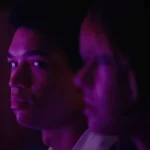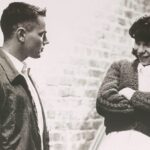Home Video Hovel: Thunderbirds Are GO/Thunderbird 6, by David Bax
Thunderbirds was a puppet action series that ran in 1965 and 1966 on British television. After its cancellation, it was followed by two features, 1966’s Thunderbirds Are GO and 1968’s Thunderbird 6. Its legacy, if nothing else, is that of a towering paean to the technocratic, anti-humanist utopianism of the jet age.
Take, for example, the opening sequence of Thunderbirds Are GO. For a full ten minutes, human characters take a literal backseat to the massive, ingenious contraptions built in miniature by the film’s effects team. Piece by piece, a massive (but actually tiny) spacecraft is put together by hydraulic steel and cranking chains. It’s both powerful and languid, a hypnotic cinema of machinery in motion at its own inexorable pace. Watching it may make you feel a little crazy, in a good way. An even if the rest of the movie—a series of episodes including galactic nightclubs and Martian florae, culminating in a mid-air rescue on a plummeting ship—doesn’t match that fascinating beginning, it’s still like getting to watch someone playing with the coolest toy set imaginable.
By 1968’s follow-up, Thunderbird 6 (both are directed by David Lane), it would seem the bloom was off the rose. There are still some creatively designed miniatures—a ski slope in the Alps stands out—but it all feels like such a trifle, even compared to its essentially hollow predecessor. Its plot, in which two of the Thunderbirds are taken hostage aboard a luxury airship, is most notable, at least to me, for being a possible inspiration for “Skytanic,” one of the all-time best episodes of Archer.
Of course the more obvious modern comedy reference point for Thunderbirds is Trey Parker’s Team America: World Police. In both cases, there’s an absolute belief in might-makes-right, Western exceptionalism. Except only one of the movies is a parody. These fantasies of unlimited defense spending find more room for rocket mounts on spaceships than they do for actual human beings, who only appear when a close-up of hands is needed, a device that never fails to be funny. It’s laughable from today’s vantage point. Plus, hey, explosions look even bigger when the things blowing up are miniature. And there are a ton of explosions.
The Thunderbirds movies were shot on non-anamorphic, 2-perf 35MM so the native image has less clarity than one would expect but the transfer is clean, there’s no real dirt or scratches and the colors are surprisingly brilliant. The audio is available in both mono and 5.1. The sound is clear if fittingly thin for a movie where everything is smaller.
Special features on Thunderbirds Are GO include a commentary with Lane and producer Sylvia Anderson, a commentary with film historians Jeff Bond and Nick Redman, multiple featurettes on the making and legacy of the film. Special features on Thunderbird 6 include a commentary with Lane and Anderson and a commentary with filmmaker Greg Ford and cartoon writer William Hohauser, as well as multiple featurettes on the puppets and ships in the movie.






























